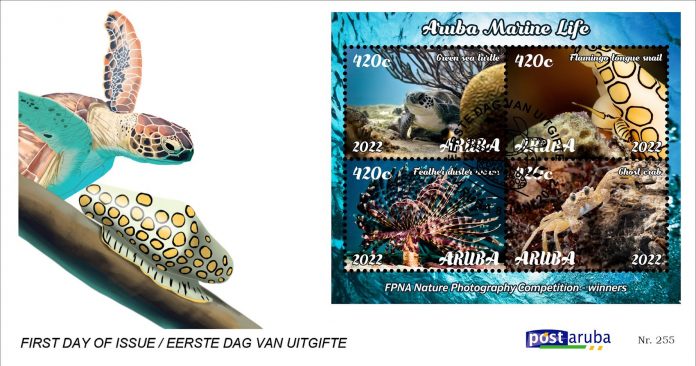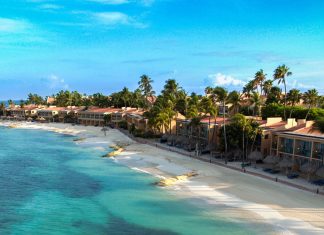On June 8, 2021, which is World Oceans Day, Post Aruba N.V. emits its stamp series ‘Marine Life’. This emission was done in collaboration with Aruba National Park Foundation through a nature photography competition held in December 2021.
This stamp emission is accompanied by a First Day Cover envelope that was designed by Mr. Armando Goedgedrag.
Description of the stamps:
Title: Floating in the current
Between Hole in the wall and Isla di Oro, Aruba by photographer: Tobia de Scisciolo
Photographer Caption:
The magnificent Feather Duster Worm is a beautiful subject and I appreciate photographing it. I particularly enjoy using them as the centerpieces of my pictures as seldomly, like in this example, you find them isolated on top of a coral which if the right angle is used, allows you to obtain this dark blue almost black background. Through this empty and dark background, I enjoy how the main subject is put forward with the strong contrast of the dark blue oceanic background.
Creature description: Feather Duster Worm
Feather duster worms are a family of filter-feeding marine tubeworms that live motionless lives. They are known for their highly branched fan of tentacles that extends from their tubes, and look like feather dusters.
A Feather duster worm is often found in the subtidal zones of reefs around the world, positioned in moderate currents where plankton meals get brought to them each day that are gentle enough to not damage their feathery crown.
The feathery crown that gives the feather duster worm its name is a specialized part of its body that is used to trap plankton and move them to its mouth.
These fan worms don’t have a face and eyes, but they are able to detect changes in the light and use that light sensitivity to protect them from predators.
If a feather duster worm detects a shadow or feels threatened, it will retreat into its tube for protection.
They also have the ability to reproduce asexually through fragmentation.
Title: The ghost crab
At Pink beach/pyramid rock behind the Arashi dunes, Aruba by photographer: Nohemy Habibe
Photographer Caption:
On my last day shooting at the ‘pink beach’ /’pyramid rock’ behind the Arashi dunes, I saw a movement out the corner of my right eye. I had spotted many ghost crabs, but none were this big. We had a moment of mutual understanding as she let me get various shots from different angles and distances.
Creature description: Ghost Crab
Ghost crabs are common shore crabs in tropical and subtropical regions throughout the world, inhabiting deep burrows in the intertidal zone. They are generalist scavengers and predators of small animals.
The name “ghost crab” derives from their nocturnality and their generally pale coloration which blends in well with the sand, though they are capable of gradually changing body coloration to match their environments and the time of day.
Characteristics of the subfamily include one claw being larger than the other, thick and elongated eyestalks, and a box-like body.
They are semi-terrestrial and breathe oxygen from the air through moistened gills. They must periodically wet their gills with seawater, usually by taking water from moist sand or by running into the surf and letting the waves wash over them. However, they can only remain under water for a limited amount of time, as they will drown.
They remain in their burrows during the hottest part of the day, and throughout the coldest part of the winter.
Ghost crabs are negatively affected by human activity on sandy beaches, such as sand trampling by foot traffic, the building of seawalls, or the presence of inorganic pollutants. Due to their worldwide distribution and the ease by which their burrows can be surveyed, ghost crab burrows are regarded as valuable ecological indicators for quickly assessing the impact of human disturbance on beach habitats.
This stamp series and First Day Cover envelope are available at all the Post Office locations, namely in Oranjestad and San Nicolas.
For more information on the “Marine Life” stamps serie please visit the Facebook page: Aruba Stamps or Webpage: postaruba.com/philatelic/

















